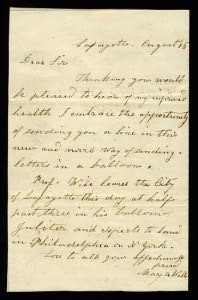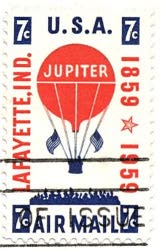
 |
The Jupiter
A cover flown on the 1859 Jupiter hot-air balloon flight, from the National Postal Museum collection, (Click here to view) will be on display at Stampshow 2003 August 7-10. Below is an excerpt from an article by Ken Lawrence regarding the Jupiter, which appeared in the April 2003 issue of Scott Stamp Monthly:
Although powered flight is now almost 100 years old, the sesquicentennial of airmail is a mere six years in the future. If postal commemoration of the Wright Brothers' flight this year can gather momentum for a new take-off, perhaps another stamp commemorating the flight of the gas balloon Jupiter in 1859, which carried the world's first officially designated airborne mail, might further lift the popularity of this wonderful collecting passion.
John Wise, who piloted the Jupiter, was the most prominent aeronaut of his day. Like most of the men who pursued that dangerous sport, he gave himself the title "Professor." A piano maker by profession, he was bitten by the balloon bug in 1835, when he was 27 years old. On his 230th flight, launched from St. Louis on July 1, 1859, Wise and three companions had flown the balloon Atlantic as far as Jefferson County, N.Y., where they crashed to the ground, establishing a world distance record of 809 miles that stood for more than 50 years.
After returning to St. Louis for his 231st ascent on July 30, Wise resumed his barnstorming tour at Lafayette, Ind., hoping to reach an East Coast city from there. A notice from Postmaster Thomas Wood appeared in the August 16, 1859, issue of the Lafayette Daily Courier, which merits recognition as the founding document of airmail service:
"All persons who wish to send letters to their friends in the East by balloon today must deliver them at the post office previous to 12 m., as the Jupiter's mail closes at that hour. The letters must be addressed with the words 'via balloon Jupiter' added to the ordinary direction, and prepaid."
A crowd estimated at 30,000, the largest gathering in Indiana history up to that time, assembled at Lafayette to witness the grand event on August 16. Wise and his son Charles made two brief demonstration launches that afternoon, but a leaky valve needed repair, so the flight was postponed until the next day.
On August 17, carrying a load of 23 pamphlets and 123 letters, the Wises finally lifted off for their planned flight to Philadelphia or New York, but failed to reach an altitude where the wind was sufficiently brisk to carry them a long distance. After being blown off course in the wrong direction, they decided to land at Crawfordsville, Ind. From there, the mail was dispatched onward by train.
A paper at Lancaster, Pa., reported on August 19, "The special letter bag expressed by the post master of Lafayette with proof of Wise's departure, was dropped from the clouds over Crawfordsville and passed through here today en route to New York in good order."
That entire batch of mail vanished from public view for the following 98 years. Finally, an article titled "A Major Philatelic Find" by F.W. Kessler in the February 16, 1957, issue of Stamps magazine announced a truly momentous discovery. The author and another unnamed airmail dealer had purchased a letter carried aboard the Jupiter from an undisclosed source.
The letter read:
 "Dear Sir:
"Dear Sir:
"Thinking you would be pleased to hear of my improved health I embrace the opportunity of sending you a line in this new and novel way of sending letters in a balloon.
"Prof. Wise leaves the City of Lafayette this day at half past three in his balloon Jupiter and expects to land in Philadelphia or N York.
"Love to all - your affectionate friend
"Mary A. Webb"
The envelope, addressed to "W H Munn, No 24 West 26 St, N York City, Via Balloon Jupiter," is franked with a 3-cent stamp of 1857 canceled La Fayette Ind. Aug 16 1859. An erroneous 1858 date has been added at the lower left in different ink from the original. The letter and cover are shown in Figure 3.
The timing of Kessler's report was impeccable. Coming as it did just a little more than two years before the Jupiter flight's centenary, it caught the attention of the collecting community and fired the collective imagination of the Citizens' Stamp Advisory Committee, which scheduled a stamp issue to commemorate the occasion.
 The 7-cent Jupiter airmail commemorative stamp (right - click for a larger view), printed in red and blue colors on the Giori intaglio press, was issued August 17, 1959, at Lafayette. Aeronaut Donald Piccard reenacted Professor Wise's flight in his hydrogen-filled Jupiter II balloon with 123 letters aboard.
The 7-cent Jupiter airmail commemorative stamp (right - click for a larger view), printed in red and blue colors on the Giori intaglio press, was issued August 17, 1959, at Lafayette. Aeronaut Donald Piccard reenacted Professor Wise's flight in his hydrogen-filled Jupiter II balloon with 123 letters aboard.
Helicopter flights carried letters from downtown Lafayette to Purdue University airport, to exemplify modern airmail transport. Later that evening, Postmaster General Arthur Summerfield addressed the dedication ceremony for the stamp at a banquet attended by Sen. Charles A. Halleck, Sen. Homer E. Capehart, Gov. Harold W. Handley, and Lt. Gov. Crawford F. Parker.
Wouldn't it be swell to have a similar reenactment and celebrity participation on the 150th anniversary in 2009? The Jupiter letter could return to its original home for the occasion, and perhaps one or more of the flown Jupiter II letters could be placed on display along with it, if any can be found.
Shortly after reporting their discovery of the 1859 letter, Kessler and his partner sold it to Thomas A. Matthews, a well-to-do Ohio collector. Matthews was the only private collector to own it. When his extraordinary airmail collection sold at auction, it was the highlight of the sale, realizing $6,100. Besides giving a copiously detailed description of the envelope and contents, H.R. Harmer's November 4, 1964, catalog called it "without doubt the only entire which resulted (after its discovery) in the issue of a postage stamp."
The buyer was the Smithsonian Institution, a purchase supported by the Bachelor Fund, donated to build its airmail holdings. Today it is housed at the National Postal Museum in Washington, part of the national stamp collection.
In the past, the Smithsonian hasn't always put the cover to best use. A major opportunity was missed in 1972, when the National Air and Space Museum held its first exhibition, titled "Ballooning 1782-1972." Among the items on display were 45 Franco-Prussian War letters sent by balloon mail during the 1870 Siege of Paris, described as the "Reverend Floyd Leach Collection, Division of Postal History, Museum of History and Technology." Had the Jupiter letter been included, a more complete and more patriotic history of airmail would have been presented.
More recently, the Smithsonian has showcased the Jupiter balloon cover as the national treasure it truly is. It was on display at the National Museum of American History later in the 1970s, and was chosen for the inaugural philatelic rarities exhibit when the National Postal Museum opened on July 30, 1993. Thanks to NPM's Ted Wilson for that background information.
The Smithsonian is an exceptionally appropriate home for the Jupiter cover, because John Wise had worked with the Smithsonian to gather meteorological data. He wrote in his memoir that he had carried a "good Smithsonian barometer" on the Jupiter balloon ascension.
Ted Wilson explains, "Wise was one of a number of volunteers who made weather observations for the Smithsonian. The Barometers they used were sometimes referred to as Smithsonian barometers, and an example of one can be found in the collection of the American Museum of Natural History."
Despite the obvious importance of the Jupiter flight, an editorial in the February 1959 issue of Airpost Journal questioned whether it had been significant enough to merit a commemorative stamp issue. Even more strident was an article titled "John Wise and the 'Jupiter' Balloon" by George A. Patterson in the December 2, 1958, issue of Western Stamp Collector, which claimed that the stamp's advocates had their history wrong.
The thrust of Patterson's argument was that ten earlier balloon flights had carried mail, so Jupiter wasn't the first. But most of his examples are ludicrous (he counted three 1831 ascents at New York and three 1834 ascents in Boston when aeronaut Charles Durant dropped printed handbills to onlookers), while the rest obscure what was most significant about the Lafayette postmaster's 1859 announcement.
Patterson's oldest example is the January 9, 1793, 15-mile flight of French balloonist Jean Pierre Blanchard from Philadelphia to Woodbury, N.J. Blanchard carried with him a passport (letter of introduction) from George Washington, which would surely be an important historical document if it can ever be found, but it was not a piece of mail.
More plausible is the case for letters carried by aeronaut Richard Clayton aboard the balloon Star of the West from Cincinnati to Waverly, Ohio, on July 4, 1835. Tom D. Crouch, author of The Eagle Aloft - Two Centuries of the Balloon in America, called this mail "the first ever carried aboard an American balloon." In fact, Professor Wise himself had carried letters on two flights prior to the Jupiter launch. If any of those covers still exist, they would be wonderful to collect.
But Crouch also noted the special importance of the Jupiter, "the first time that stamped letters, which had passed through a post office, had been flown." I would add: it was also the first time members of the public were invited to post letters with the promise that they would be carried by air en route to their destinations.
Thanks to Wilson Hulme at the National Postal Museum for providing images of the flown Jupiter letter and information about its acquisition by the Smithsonian Institution. Crouch's book The Eagle Aloft, an excellent source for more information on these events, was published in 1983 by Smithsonian Institution Press.